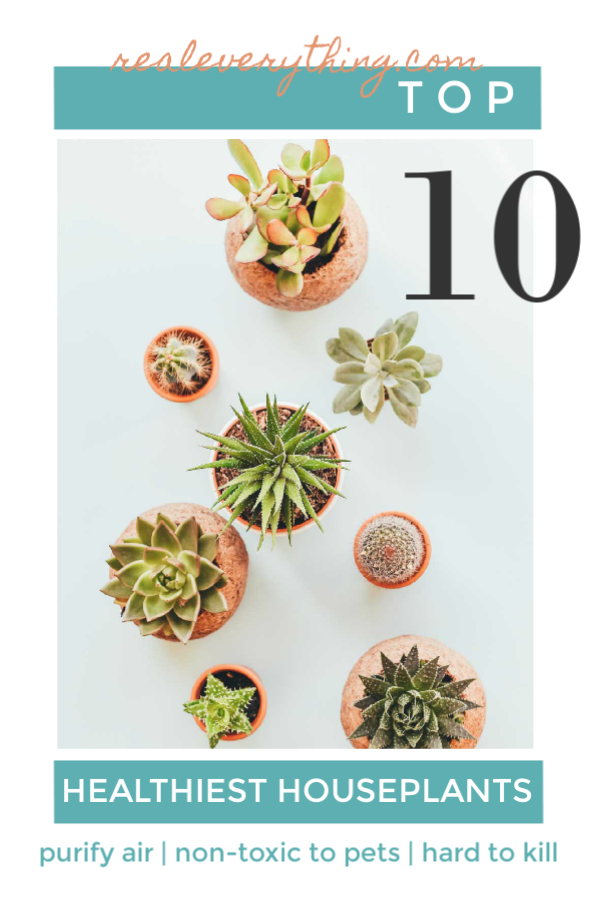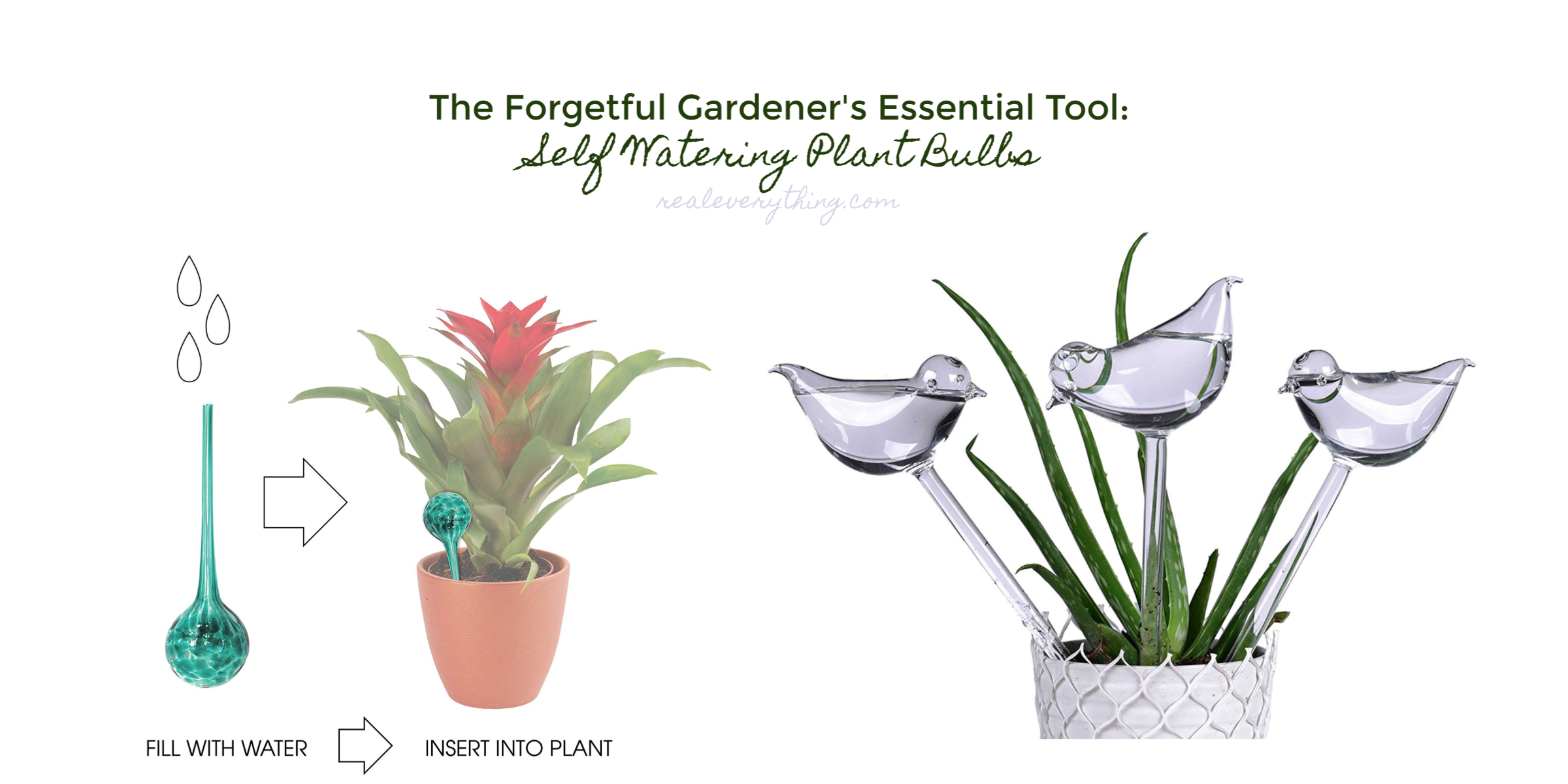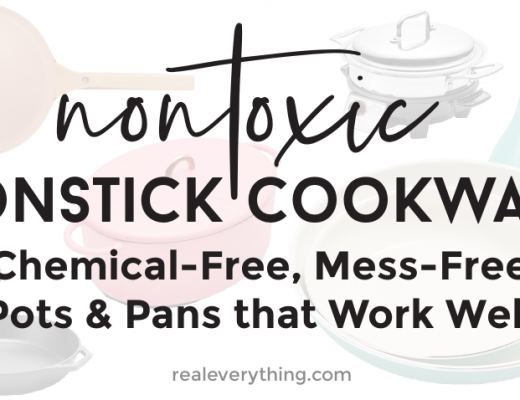Since the 1989 NASA study on air purification, we’ve known house plants are excellent detoxifiers for our homes. Yes, that’s right, it’s been THIRTY years. And yet, despite being able to put a man on the moon, the struggle is still so real for a lot of us to even keep a plant alive. Even more complex, is that different types of plants like different things – to water daily or to let them dry out, to put in direct or indirect sunlight… not to mention some are toxic to pets. It’s no wonder so many of us are too intimidated to start with this basic, affordable detoxification system! Let’s tackle what the best ones to start with are.
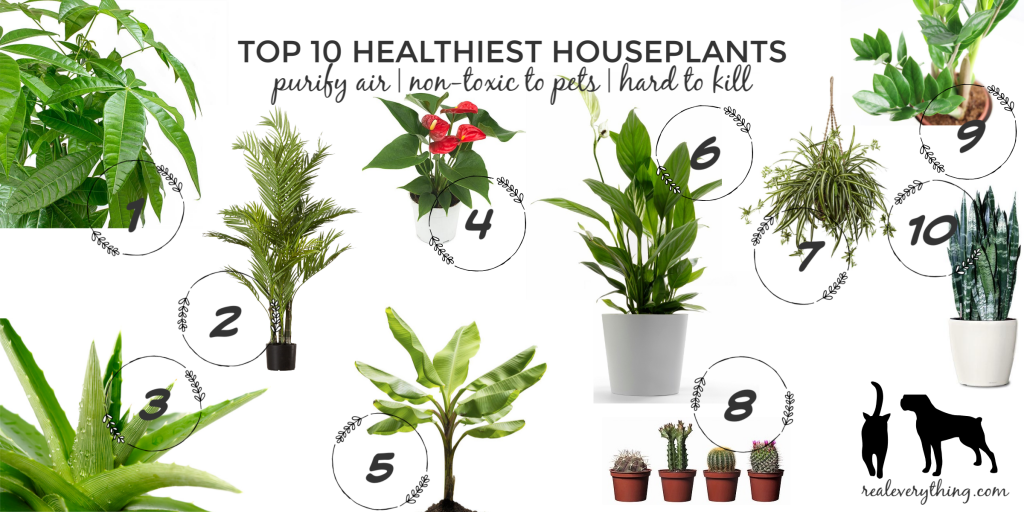
Top 10 Healthiest Houseplants that purify air, are non-toxic to pets, and are hard to kill:
- Pachina (Money Tree)
Our first intentional air purifier, this sturdy tree doesn’t require much sunlight, likes when you forget to water it, and does an excellent job purifying the air without posing risk to pets. [we named our Oprah, because she’s a money tree with big hair – and thinking of her as a friend helps remind us to take care of her] - Areca Palm
An ideal alternative for those who love ferns, this one is safer for pets and grows well in the shade. - Aloe Vera*
While toxic to pets if they eat it, this plant doesn’t shed leaves and would be safer out of pet’s reach, with added immense health benefits for being an in-house first aid for burns and cuts. - Flamingo Lily
Sister to the ideal Peace Lily, this bright red version requires more sun but is in perpetual beautiful bloom and is hard to kill (sorry, no cats). - Banana Tree
For those wistful for the fickle fig tree that’s toxic to pets, this is a great big-leafed alternative that’s safer for pets and easier to keep alive. - Peace Lily
The highest of the air purifying results that is non-toxic to dogs (sorry, cats) and hard to kill, this one’s a no-brainer! - Spider Plant
Your friendly neighborhood spider plant is an easy grower in nearly all conditions, even full shade. - Cactus
For the seriously plant challenged, these hearty friends will stand the test of time and even just their soil will help! - Zamioculcas zamifolia (ZZ)*
A hearty grower with little water in the shade, this plant is toxic to pets but is low-risk from lack of shedding leaves.
- Variegated Snake Plant (Mother in Law Tongue)*
The 2nd highest of the air purifying results, although toxic to pets these hearty plants grow up and don’t shed – easy to keep away from pets.
But… it took a LOT of research to figure out which ones to recommend, all factors considered. So, let’s start by breaking down one aspect at a time.
What’s in our air that plants could help purify?
Within the 1989 NASA study, the first 3 toxins – benzene, formaldehyde, and trichloroethylene reduction from air were measured. In more modern studies, additional chemicals have been measured, including xyelene and ammonia.
Benzene
Toxic, volatile, flammable liquid hydrocarbon byproduct of coal distillation. Benzene is used as an industrial solvent in paints, varnishes, lacquer thinners, gasoline, etc. Benzene causes central nervous system damage acutely and bone marrow damage chronically and is carcinogenic. It was formerly used as parasiticide. [source]
Formaldehyde
Formaldehyde is a colorless poisonous gas synthesized by the oxidation of methanol and used as an antiseptic, disinfectant, histologic fixative, and general-purpose chemical reagent for laboratory applications. Formaldehyde is used as a disinfectant and to preserve biological specimens. Environmentally, formaldehyde may be found in the atmosphere, smoke from fires, automobile exhaust and cigarette smoke. In solution, it has a wide range of uses: in the manufacture of resins and textiles, as a disinfectant, and as a laboratory fixative or preservative. Formaldehyde is a highly reactive aldehyde gas formed by oxidation or incomplete combustion of hydrocarbons. Small amounts are produced during normal metabolic processes in most organisms, including humans. Formaldehyde solution (formalin) is considered a hazardous compound, and its vapor toxic. [source]
Trichloroethylene
Trichloroethylene is a synthetic, light sensitive, volatile, colorless, liquid that is miscible with many non-polar organic solvents. Trichloroethylene is used mainly as a degreaser for metal parts. Upon combustion, it produces irritants and toxic gases. Occupational exposure to trichloroethylene is associated with excess incidences of liver cancer, kidney cancer and non-Hodgkin lymphoma. It is reasonably anticipated to be a human carcinogen.
Dimethylbenzenes & Xylene
Dimethylbenzenes (p-Xylene, m-Xylene, and o-Xylene) are all in the Benzene family. Xylene is also a Formaldehyde Resin. [source]
Ammonia
Ammonia is a colorless alkaline gas. It is formed in the body during decomposition of organic materials during a large number of metabolically important reactions. It is essential for many biological processes and has various industrial applications. Ammonia is a colorless inorganic compound of nitrogen and hydrogen with the formula NH3, usually in gaseous form with a characteristic pungent odor. Ammonia is irritating to the skin, eyes, nose, throat, and lungs. [source]
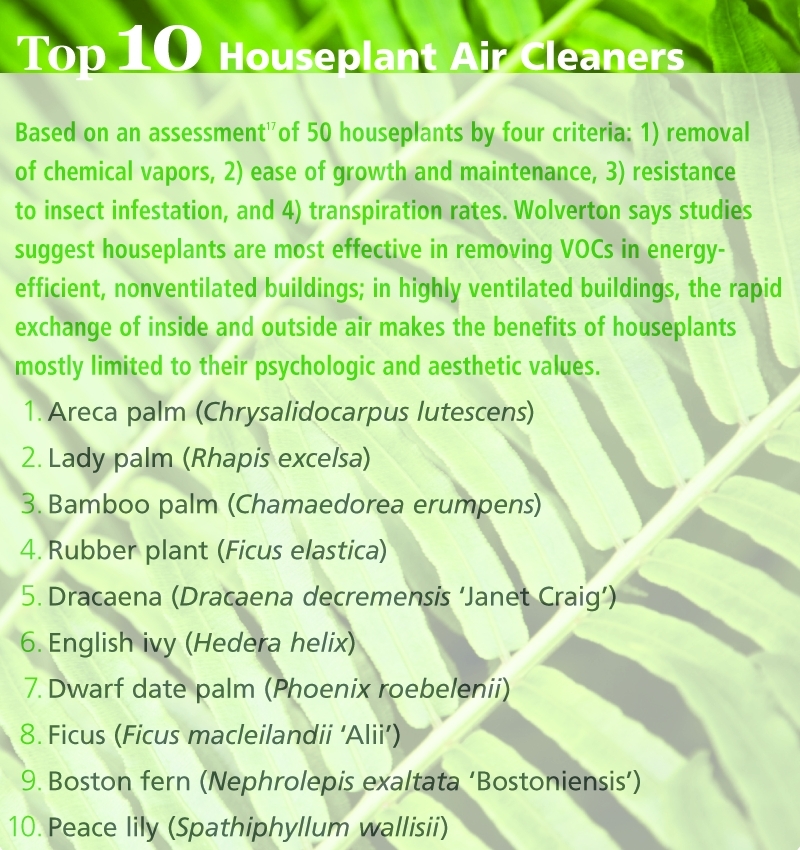 If only concern is best air filters, these are the top 10,
If only concern is best air filters, these are the top 10,
but many are toxic to animals or difficult to grow
image from source 4, click here for more info
Why are plants good detoxifiers and which are best?
It stands to reason that as plants take in the air they need for photosynthesis, they trap some of the toxic chemicals that surround us everyday. And because they do this quietly, cheaply, and don’t need to have their filters changed, plants are probably our most useful defense against these harmful substances that we would otherwise be breathing in.
There have been many studies of houseplants as air purifiers and so the information we have is pretty robust, especially since there is a great interest in using plants on long space flights to clean the air, produce oxygen and potentially be used as food sources.
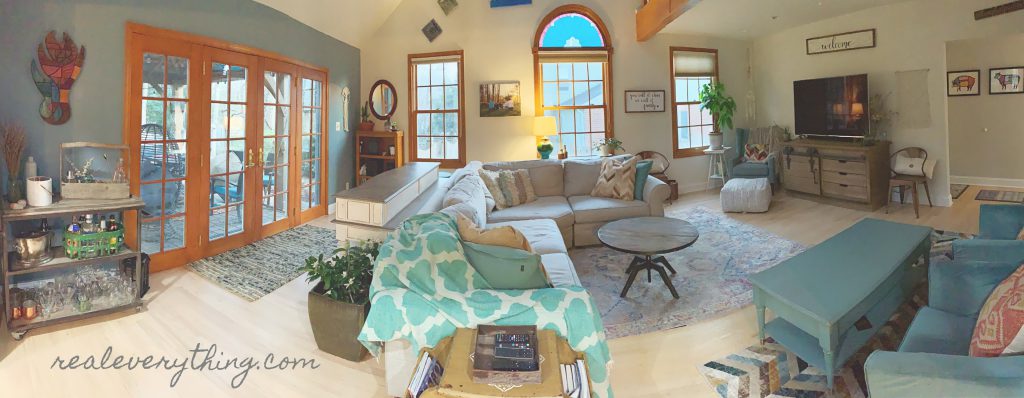 I spy: cactuses, money tree, and aloe vera in our main living space.
I spy: cactuses, money tree, and aloe vera in our main living space.
How Plants are Air Purifiers
Plants take in air and extract what they use (mainly Carbon Dioxide), and release much of the rest, similar to how animals breath. But because of the unique way that plants refeed their soil, many organic compounds aren’t released, but taken into the stem and root system to be sequestered in the soil. Not only does this take volatile organic compounds out of air circulation (and out of your lungs), but it also feeds the soil microbes which also have the ability to take in these toxic compounds. This process turns toxins into something useful!
Of course, not all organic toxins can be processed by plants this way and some plants are better at certain toxins and not others. That’s where the research comes in. Studies have shown that leafy, usually non-flowering plants are the best at sequestering toxins, such as ivies, palms, ferns and the like.
Low-light-requiring houseplants, along with activated carbon plant filters, have demonstrated the potential for improving indoor air quality by removing trace organic pollutants… [and] is one of the most promising means of alleviating the sick building syndrome …The plant root-soil zone appears to be the most effective area for removing volatile organic chemicals. [1]
The NASA study
The NASA study was extremely robust. Not only did they test the ability of plants to sequester various compounds, but they also tested if this effect was still present if leaves were removed as well as if soil bacteria alone would sequester the toxic compounds.
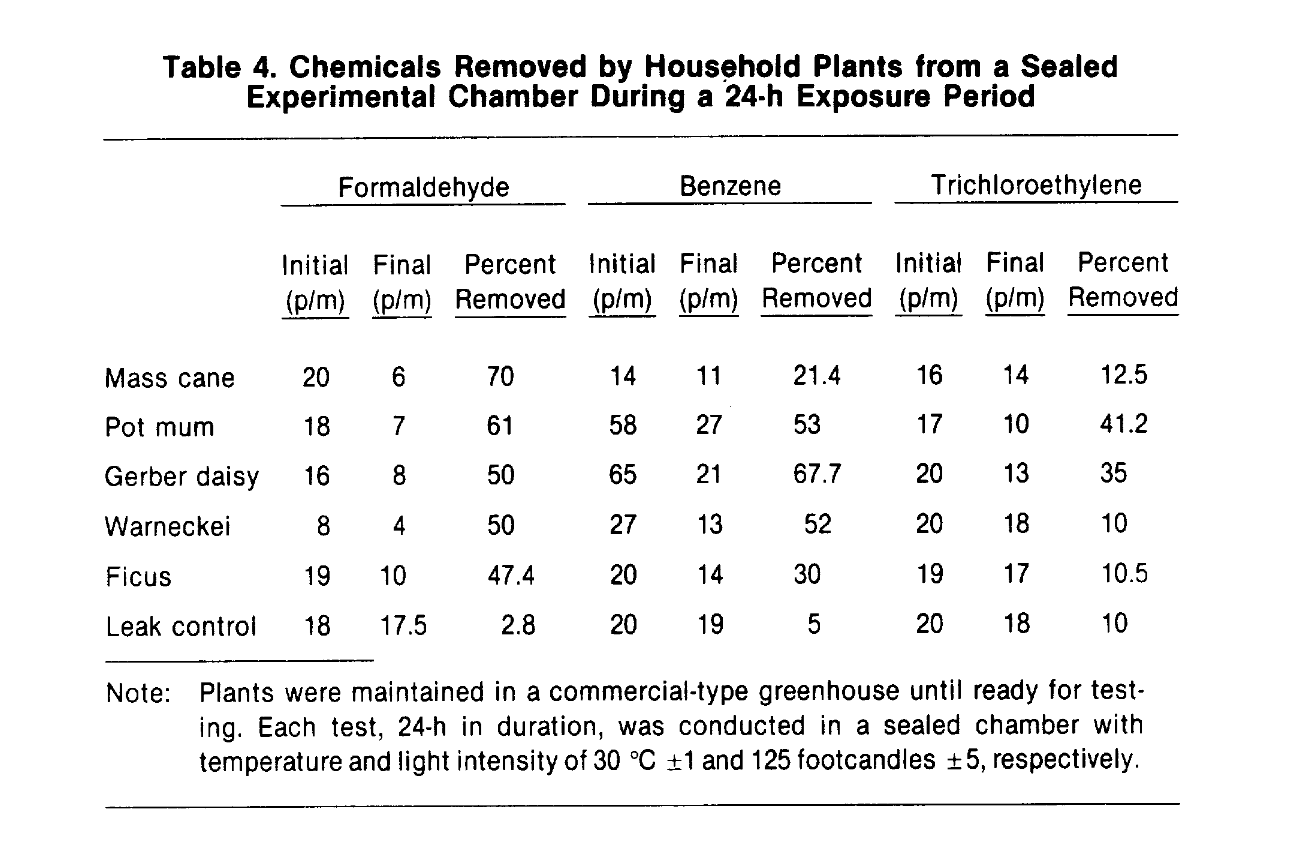 In this experiment, they placed different plants in environments rich in volatile organic compounds to see how much they could remove. Every plant they tested was working to remove these compounds much more that the control could leak it out! Some were incredibly efficient, removing 2/3 of the compound from their environment.
In this experiment, they placed different plants in environments rich in volatile organic compounds to see how much they could remove. Every plant they tested was working to remove these compounds much more that the control could leak it out! Some were incredibly efficient, removing 2/3 of the compound from their environment.
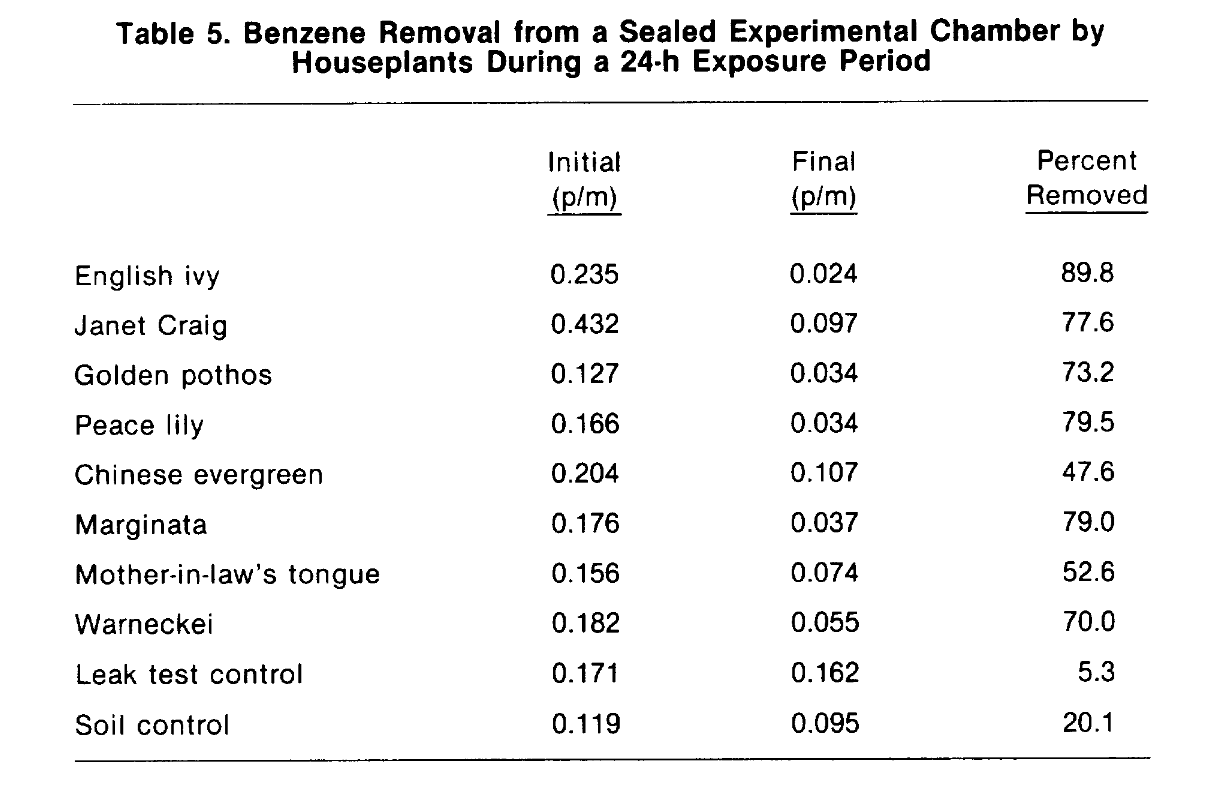
In this experiment, they tracked Benzene removal among varies leafy plants as well as just soil alone. Even the soil was removing 4 times as much Benzene as was leaking out. And the English Ivy removed 90% of the Benzene!
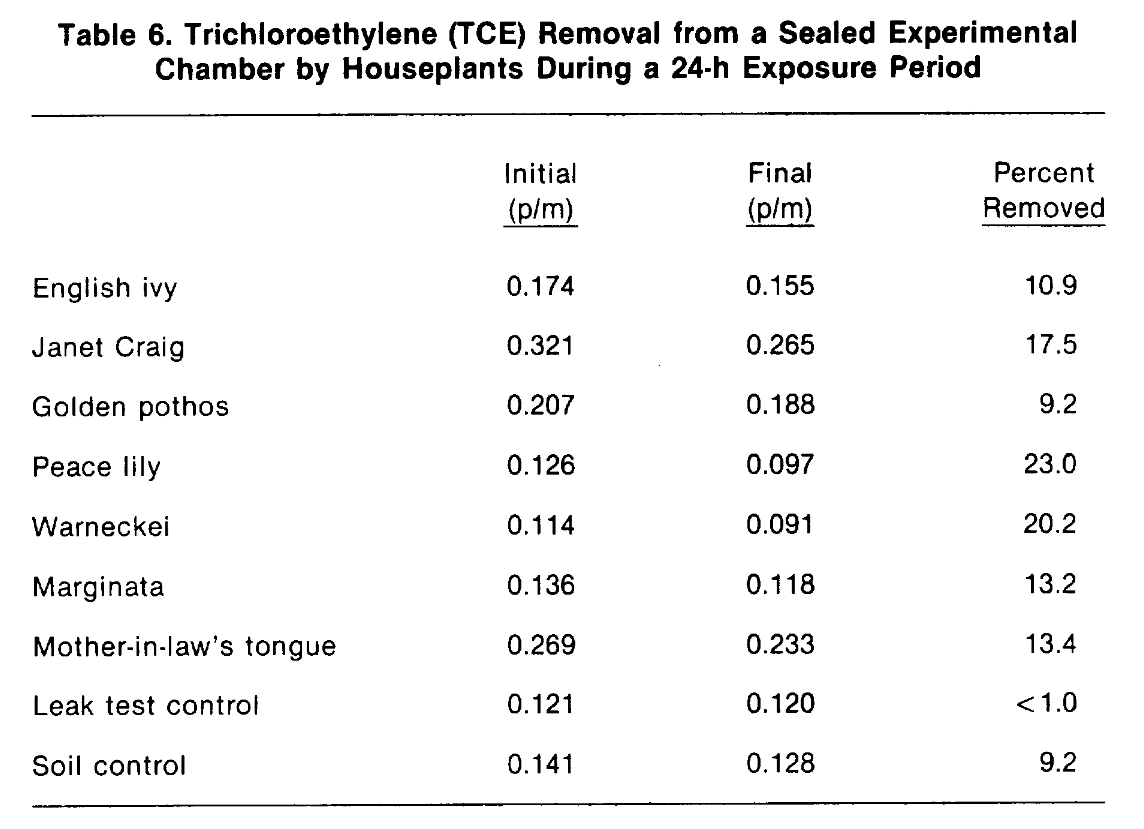
This experiment tested Trichloroethylene removal and found while plants weren’t as capable in removing it as well as they could remove Benzene, some species such as the Dracaena and the lily were still sequesting 20% and the soil itself was accounting for 9% of the removal.
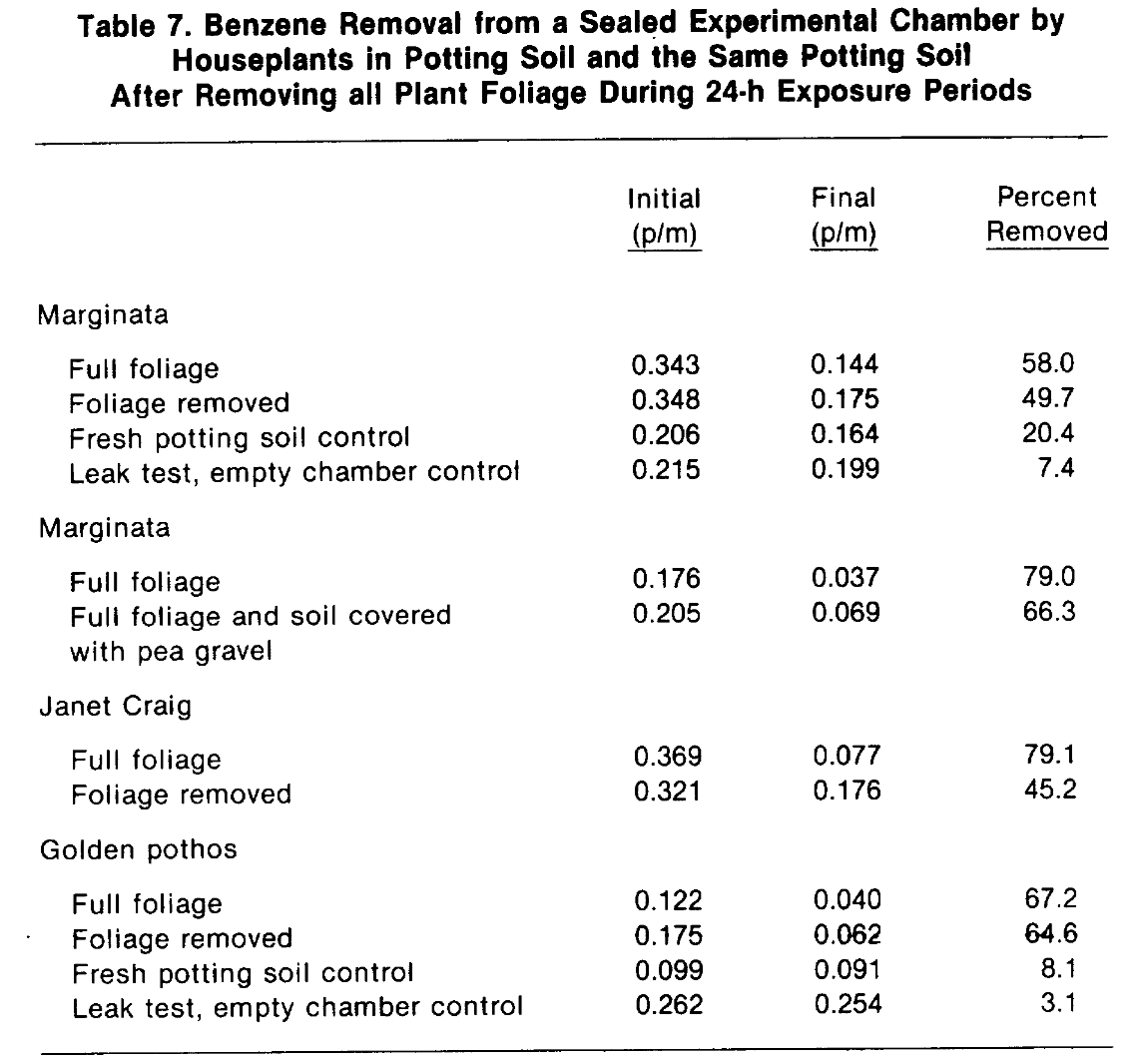
Here they tried to determine how much of the removal process was due to action in the leaves as opposed to the stem and root system. While the leaves certainly made a difference, it seems that the majority of the effect is still there even when the leaves are not. So even your sad, dying plant in the shady corner is still working for you!
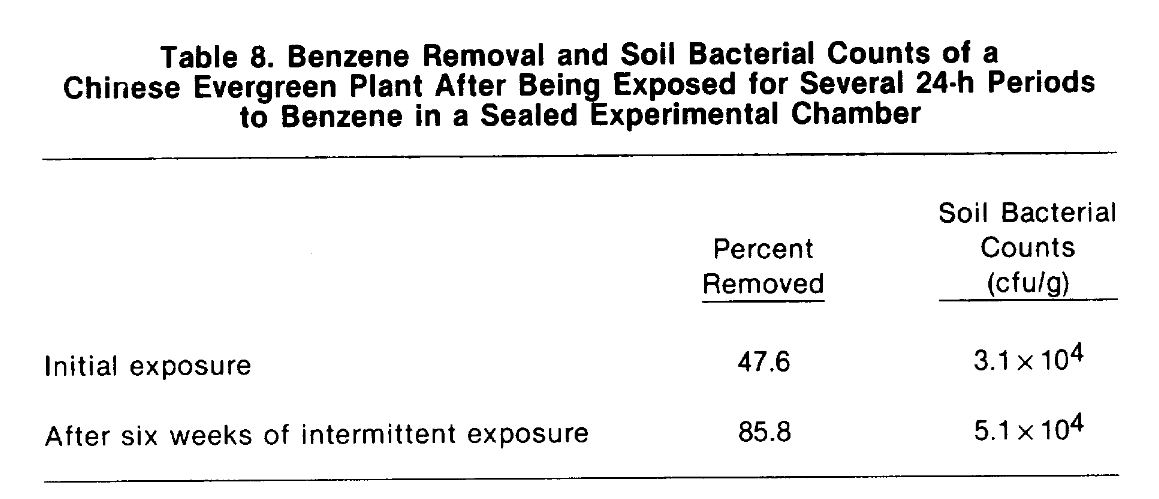
Finally, soil bacteria play a major role in removal of toxins as well. This experiment showed that Benzene was removed by soil bacteria and, in fact, fed them and increased their populations. So even if your plant died and you’re just watering a pot of dirt, you’re still doing something for your air quality!
Which Plants May Harm Our pets?
I don’t know about you, but we have a cat that loves to chew leaves. Also, we have a puppy that is exploring the world mouth first. So when we were picking out plants, it was important to us to keep toxic plants out of the reach of our animals. Plants are not “toxic” or hazardous to them unless consumed, so if out of reach you and they will be safe.
Lots of plants can cause a reaction in your pets, from mild irritation all the way to instant death. You should definitely be aware of potential hazards before you bring them into your house. The ASPCA keeps a database of plants that could be toxic to dogs or cats here.
These toxins range from calcium oxalates in ivies which might cause mouth and throat irritation and possibly vomiting to saponins which cause digestive distress to alkaloids which could be deadly.
However, if something is toxic, there are still ways to keep it in your house without harming your pets. For example, we have a snake plant, which is a good detoxifier but potentially toxic to our pets. Because of its danger, we keep it on a pedestal which doesn’t have room for our cats to sit on and have potted it in a planter large enough to catch any dead leaves, to prevent them from falling on the floor.
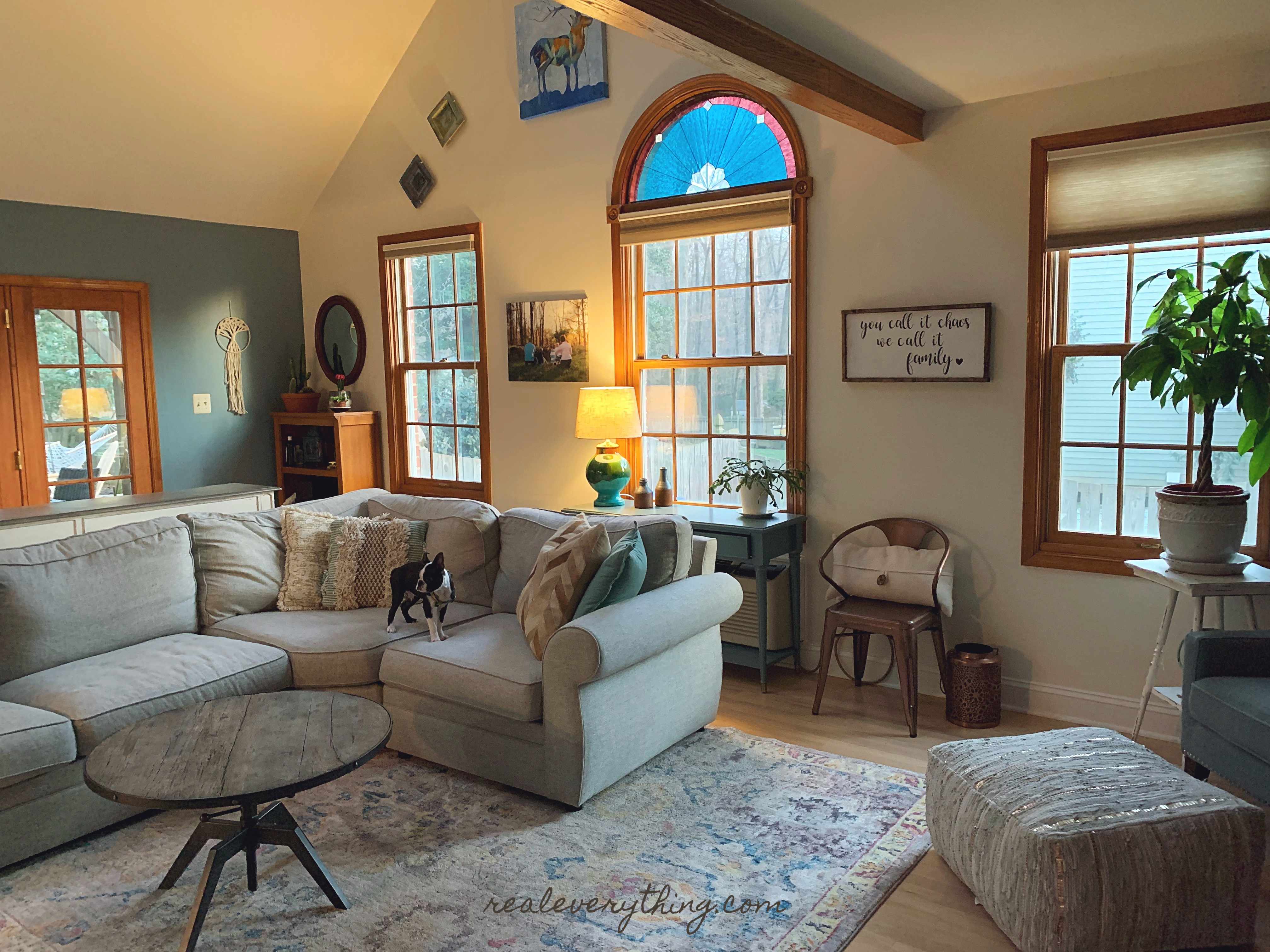 A wild Penny puppy, spotted in her element: awaiting snuggles on the sofa!
A wild Penny puppy, spotted in her element: awaiting snuggles on the sofa!If you have pets and a black thumb, what plants are good for you?
Plants that purify, are non-toxic, are more hearty, and do not require full sun are noted in green below. While we’ve selected a couple exceptions to the rule and why, for the most part using this guide has helped us add plants that have stayed alive for nearly a whole year now! [if on your phone, turn the screen to the side so you can see all 7 columns of the below table]
| Plant | Air Purifier | Toxic to Cats |
Toxic to Dogs |
Watering | Sunlight | Hard to Kill |
|---|---|---|---|---|---|---|
Dwarf Date Palm |
Formaldehyde, xylene and toluene | No | No | Moderate | Full Sun to Partial Shade |
No |
Areca Palm |
Xylene, formaldehyde, and toluene | No | No | Moderate | Partial Shade | Yes |
Boston Fern |
Formaldehyde, xylene and toluene | No | No | Moderate | Partial Shade to Full Shade |
No |
Kimberly Queen Fern |
Formaldehyde, xylene and toluene | No | No | Moderate | Partial Shade to Full Shade |
No |
English Ivy |
Benzene, formaldehyde, trichloroethylene, xylene and toluene |
Yes | Yes | Wet to Moderate | Full Shade | Yes |
Spider Plant |
Formaldehyde, xylene and toluene | No | No | Moderate | Partial Shade to Full Shade |
Yes |
Devil’s Ivy |
Formaldehyde, xylene and toluene | Yes | Yes | Moderate | Partial Shade to Full Shade |
Yes |
Peace Lily |
Benzene, formaldehyde, trichloroethylene, ammonia, xylene and toluene | Yes | No | Wet to Moderate | Partial to Dappled Shade |
Yes |
Flamingo Lily |
Formaldehyde, ammonia, xylene and toluene | Yes | No | Moderate | Full Sun to Partial Shade |
Yes |
Chinese Evergreen |
Benzene and formaldehyde | Yes | Yes | Moderate | Partial to Dappled Shade |
Yes |
Bamboo Palm |
Benzene, formaldehyde, trichloroethylene, xylene and toluene |
No | No | Moderate | Full Shade | No |
| Variegated Snake Plant* | Benzene, formaldehyde, trichloroethylene, xylene and toluene |
Yes | Yes | Moderate | Partial Shade to Full Shade |
Yes |
Heartleaf Philodendron |
Formaldehyde | Yes | Yes | Moderate | Partial Shade to Full Shade |
Yes |
Selloum Philodendron |
Formaldehyde | Yes | Yes | Moderate | Partial to Dappled Shade |
Yes |
Elephant Ear Philodendron |
Formaldehyde | Yes | Yes | Moderate | Partial Shade to Full Shade |
Yes |
Red-edged Dracaena
|
Benzene, formaldehyde, trichloroethylene, xylene and toluene |
Yes | Yes | Moderate | Partial Shade to Full Shade |
Yes |
Cornstalk Dracaena |
Benzene, formaldehyde, and trichloroethylene | Yes | Yes | Moderate | Partial Shade to Full Shade |
No |
Weeping Fig |
Formaldehyde, xylene and toluene | Yes | Yes | Moderate to Moderately Dry |
Full Sun to Partial Shade |
No |
Barberton Daisy |
Benzene, formaldehyde, and trichloroethylene | No | No | Moderate | Full Sun to Partial Shade |
No |
Florist’s Chrysanthemum |
Benzene, formaldehyde, trichloroethylene, ammonia, xylene and toluene |
Yes | Yes | Moderate | Full Sun to Partial Shade |
No |
Rubber Plant |
Formaldehyde | Yes | Yes | Moderate | Full Sun to Partial Shade |
Yes |
Dendrobium Orchids |
Ammonia | No | No | Moderate | Full Sun to Partial Shade |
No |
Dumb Canes |
Ammonia | Yes | Yes | Moderate | Partial Shade to Full Shade |
No |
King of Hearts |
Ammonia | No | No | Moderate | Partial Shade to Full Shade |
No |
Moth Orchids |
Ammonia | No | No | Moderate | Partial or Dappled Shade |
No |
| Aloe Vera* | Benzene and Formaldehyde | Yes | Yes | Dry | Full Sun to Partial Shade |
Yes |
Janet Craig Dracaena |
Benzene, formaldehyde, and trichloroethylene | Yes | Yes | Moderate | Partial or Dappled Shade |
Yes |
Warneckei Dracaena |
Benzene, formaldehyde, and trichloroethylene | Yes | Yes | Moderate | Partial Shade to Full Shade |
Yes |
Banana Tree
|
Formaldehyde | No | No | Moderate | Full Sun to Partial Shade |
Yes |
Pachina Money Tree (Scindapsus aureus)
|
Benzene, formaldehyde, trichloroethylene, xylene and toluene |
No | No | Moderate | Partial Shade to Full Shade |
Yes |
| Zamioculcas zamifolia(ZZ or Zanzibar Gem)* | Toluene and xylene | Yes | Yes | Moderate to Moderately Dry |
Full Shade | Yes |
Cactus
|
Unknown, but soil will at least detoxify |
No | No | Moderately Dry | Partial or Dappled Shade |
Yes |
Water Scale From Dry to Moderate to Wet. Light Scale From Full Shade to Partial Shade to Partial or Dappled Shade to Full Sun to Partial Shade to Full Sun.
*Note: we chose to include the Snake Plant, ZZ, and Aloe in our homes, despite their toxicity for animals, because of their health benefits. All are out of reach of pets and do not “shed” leaves, making them less of a risk for our home – but be mindful about placement for these 3 plants if you have pets.
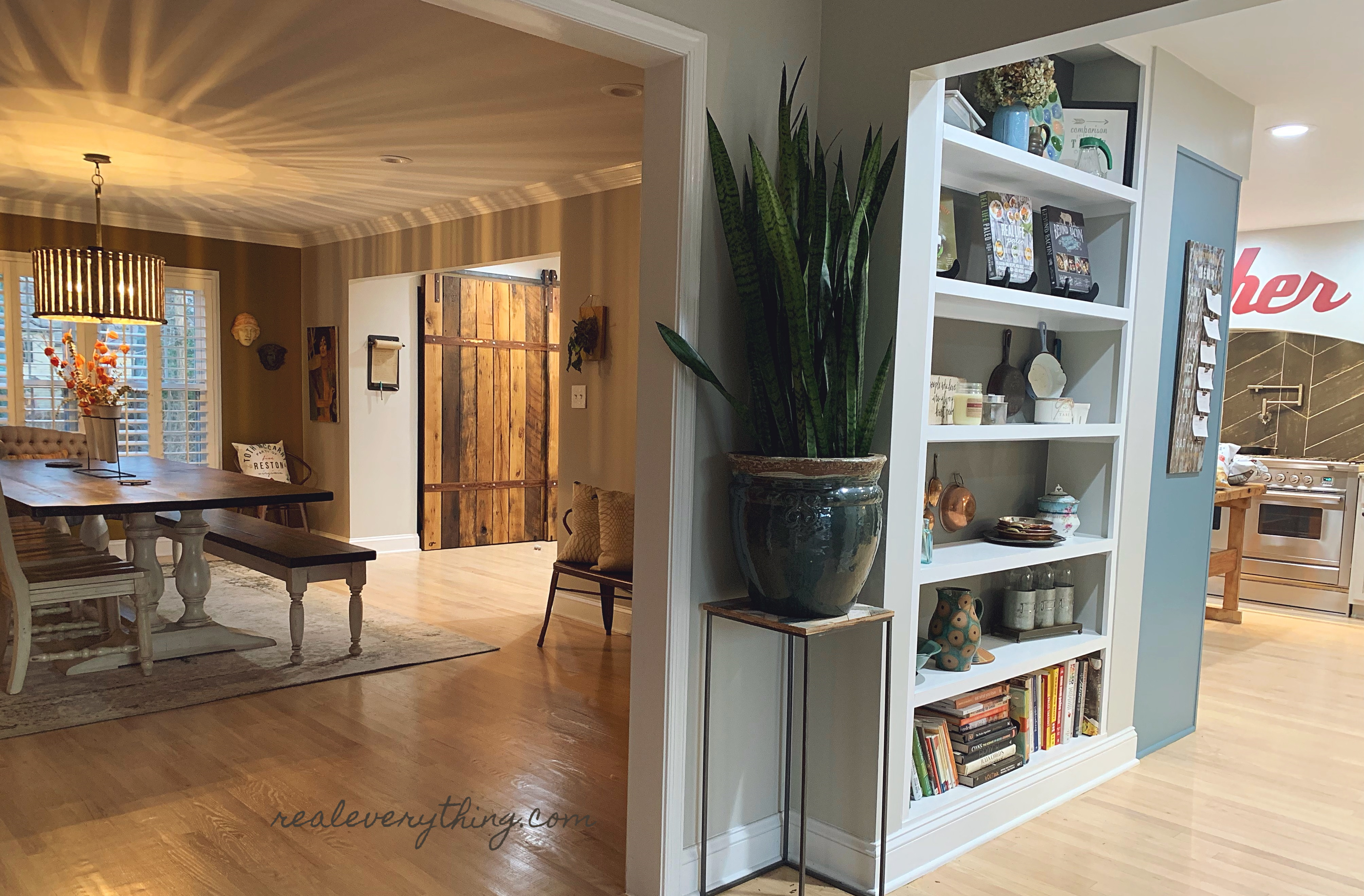 Look close enough and you can see they dying air plant we killed from over-watering on the wall… learn from our mistakes!
Look close enough and you can see they dying air plant we killed from over-watering on the wall… learn from our mistakes!
A Recovering Plant-Killers Recommendations for Success
When picking a houseplant, keep in mind that you have to take care of it if you want it to stay alive. Some plants are less needy than others. For example, we have forgotten to water our Christmas cactus for months and it’s still with us. Other plants we have tended to very closely and still managed to kill.
Take a look at the spot you want to keep a plant. How much sun is it getting in that spot? 12 hours? 6 hours? 2 hours? Different plant need different sun amounts, and some can survive with only indirect sun. Your care instructions should tell you what is needed. Stay away from plants that require full sun if you’re keeping it inside. Only a greenhouse will be both indoors and full sun! We picked plants that only required partial shade or full shade, because those are the ones that can be placed in more locations.
Plants also need water, so be sure to give them the proper amount. Plants can dehydrate, but plants can also drown. Be sure to drain and remove the excess as well, since harmful bacteria love standing water and can infect the roots of your plant. We try not to pick plants that need constant water because we are forgetful and would certainly kill those species!
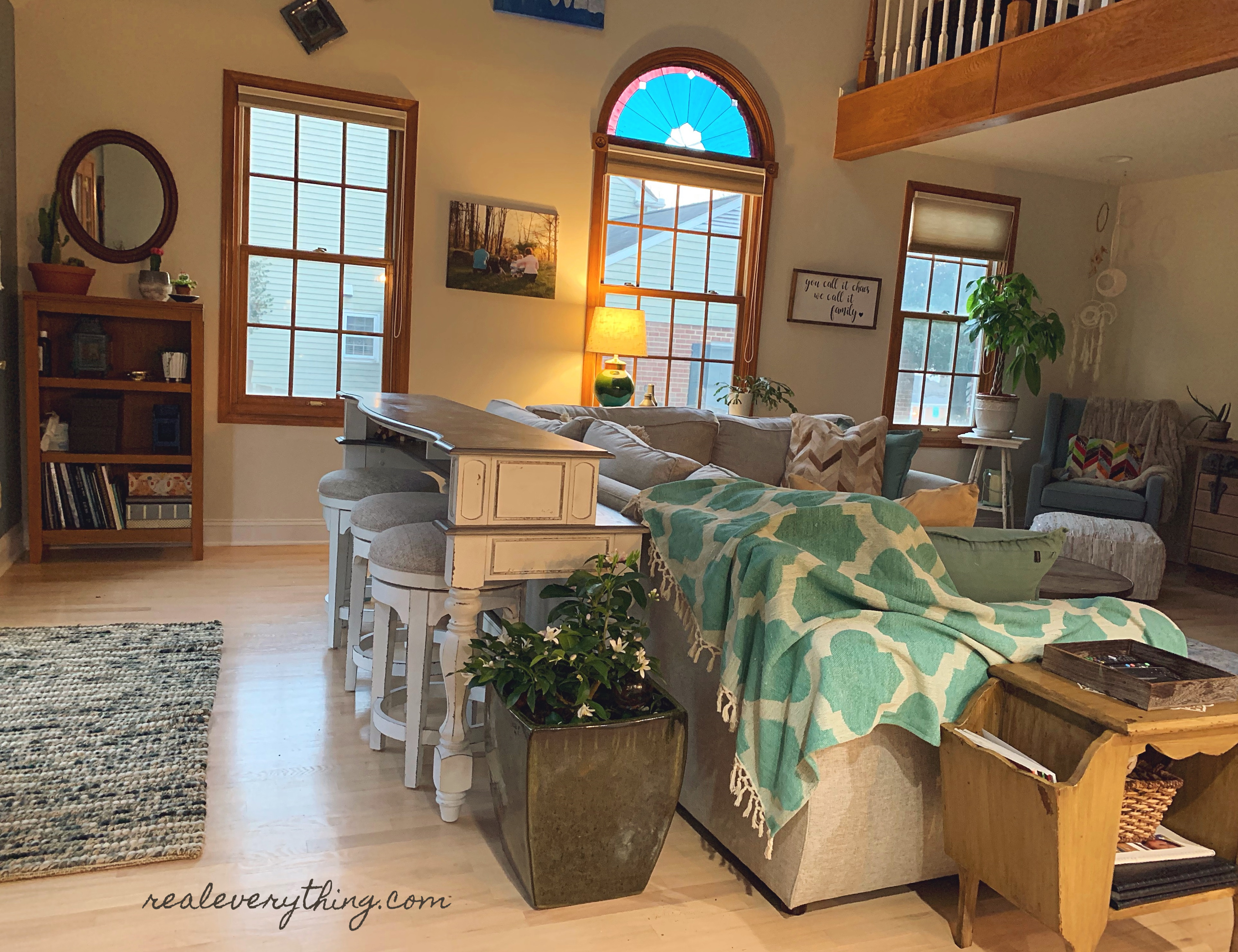
Summary
- Our personal recommendation is to choose plants with the same watering needs, and set a reminder to do so regularly.
Try this, “Alexa, set a reminder to water the plants every Tuesday, Thursday and Sunday at 8am.” If you get one plant that needs to be dried out before it’s watered again and a plant that needs to be watered regularly, you’ll for sure mix them up or do the same thing for both and kill the poor babies. Keep it simple! - Pay attention to the sunlight needs of your pants.
Don’t buy a plant because you like the way it looks and you think it’ll look good in a certain place. Been there, done that… you’ll end up with a dead plant in the center of your foyer! In the winter, a plant that did OK in indirect summer sunlight may need more direct sunlight – be prepared to move your plants depending on their needs. - Ask the experts at the garden center!
They’ll listen to your every confused question and random home detail (well… the foyer gets some sunlight from frosted glass, and know you mean, “indirect light”). They’ll also be able to recommend changes, fertilizers, etc. if you’ve gotten yourself into a desperate situation. - If you’re not a good gardener, don’t be cheap.
I realize that half-dead hanging plant at Home Depot would be so cute if you just gave it your love… but you know as well as I do that all you’ll do it over-love that plant and kill it with too much water. Stick with plants who come healthy, happy and resilient to your home! Because this was a goal of ours this year, we budgeted for plants and decorative containers into our home renovation budget, it made a huge difference!
Last but not least: purchase yourself a self watering globe for your plants that need more wet soil! We’ve got one of these in our Myer Lemon tree, and so far so good! These colored glass ones are beautiful, but I also love these cute bird ones!
UPDATE: our lemon tree died. I recommend not using these because they likely will over water your plant, and instead set-up reminders for yourself instead!
Love learning about non-toxic living? Join our e-mail lists to never miss new educational content!
Want more info on our Real Life? Healthy recipes, parenting tips, and general lifestyle stuff goes out in our Real Everything newsletter, join here.
Want more info on safer skincare and living Healthy Inside & Out? Education information, product recommendations, and specials can be found if you join here.
More information & sources:
 source: LifeHacker’s Best Air Plants graphic, full image & post here
source: LifeHacker’s Best Air Plants graphic, full image & post here
SOURCES:
- NASA Study, Interior Landscape Plants for Indoor Air Polution Abatement, 1989.
- American Society for Horticultural Science. Indoor plants can reduce formaldehyde levels. ScienceDaily. February 20, 2009.
- Efficiency of volatile formaldehyde removal by indoor plants: contribution of aerial plant parts versus the root zone. Horticultural Science 133: 479-627.
- Planting Healthier Indoor Air, Environ Health Perspect. 2011 Oct; 119(10): a426–a427. Published online 2011 Oct 1.
- Wikipedia’s NASA Clean Air Study page (source of original table which inspired ours here)

